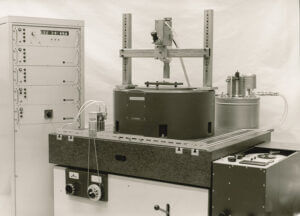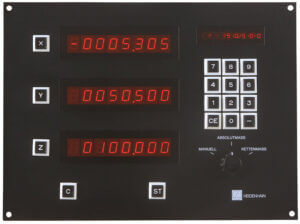HEIDENHAIN History: Technological Change
![]() HEIDENHAIN has been in existence for over 125 years, with an illustrious history. Originating in Europe and now with approximately 10,000 employees worldwide, HEIDENHAIN continues to serve as an important and significant force in the precision measurement and motion control industry. This article is the third installment in a series to share its background.
HEIDENHAIN has been in existence for over 125 years, with an illustrious history. Originating in Europe and now with approximately 10,000 employees worldwide, HEIDENHAIN continues to serve as an important and significant force in the precision measurement and motion control industry. This article is the third installment in a series to share its background.
 After seventy years in existence, the 1960s and 70s proved monumental for DR. JOHANNES HEIDENHAIN Corporation in Traunreut, Germany. Growing by leaps and bounds, some technological innovations came to full light, beginning with the development of the first true absolute rotary encoder in 1964. It was called the ROC series.
After seventy years in existence, the 1960s and 70s proved monumental for DR. JOHANNES HEIDENHAIN Corporation in Traunreut, Germany. Growing by leaps and bounds, some technological innovations came to full light, beginning with the development of the first true absolute rotary encoder in 1964. It was called the ROC series.
This ROC series was the first rotary encoder that could produce especially high accuracies with a resolution of 17 bits (131,072 counts per revolution). It became popular within the world’s machine tool market very quickly and proved to be a turning point in precision measurement technology.
Then in 1966, HEIDENHAIN was called upon by the German national metrology institute (called PTB) to build an interferential comparator to serve as the master that defines the meter. And a few years following, in 1969, the PTB asked HEIDENHAIN to build an angle-measuring table that was able to provide significant measurements never before possible (measuring step of 0.1″ and accuracy of ±0.3″). Both projects were a success (pictured at right).
At this time, much precision measurement in R&D was going on in Traunreut, and HEIDENHAIN’s first digital readout was introduced for manual machine tools in 1968. Soon after, HEIDENHAIN introduced TNC controls (pictured below).
 Continuing on technological breakthroughs, HEIDENHAIN introduces the ROD 800 in 1975, an incremental angle encoder that boasts incredible accuracy of ±1″ (incremental line count of 36,000 on a glass disk), and becomes a staple in the machine tool world, especially on index and rotary tables.
Continuing on technological breakthroughs, HEIDENHAIN introduces the ROD 800 in 1975, an incremental angle encoder that boasts incredible accuracy of ±1″ (incremental line count of 36,000 on a glass disk), and becomes a staple in the machine tool world, especially on index and rotary tables.
The motion control world had truly taken notice of HEIDENHAIN, and company subsidiaries began to open internationally. In 1965, HEIDENHAIN’s North American headquarters opened in the United States in Illinois where it remains (though now in a larger space) today.
Stayed

